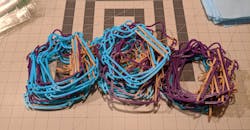As we all know, over the past few months manufacturers around the world leaped into action to help fight the pandemic and provide much needed medical supplies and personal protection equipment (PPE).
However, the desire and initiative to help was not limited to efforts of large manufacturers. Because key players within the additive or 3D printing community openly shared designs, a widely dispersed army of technology users were ultimately empowered to contribute.
GE Additive Engineer Mark Fuller wanted to design a face mask that would be easy, low-cost and fast to make and flexible enough for anyone to use, regardless of the materials they had on hand. He surveyed the mask designs the 3D-printing community was churning out and noticed flaws. One popular 3D model took 10 hours to print, another couldn’t be printed successfully and a third that got a lot of attention required a scuba mask and specific HEPA filters.
“I designed it in a way that you can take the same core geometry and go and injection mold them or go and laser cut them,” says Fuller. “What machines are not being utilized for production today can be used to help save lives.”
After posting his prototype to a Facebook group focused on open-source medical equipment to fight COVID-19, Fuller received numerous suggestions about how to improve the mask frame such as a thinner nose area and more flexible plastic. He worked the suggestions into a second design, printed some at home, and through the GE Additive COVID-19 Task Force, began sending them to local hospitals.
The design takes about 15 minutes to print and costs, in Fuller’s estimate, about 9 cents worth of plastic. It also works with just about any filter materials on hand, from an air conditioner filter to a piece of terry cloth to a paper towel.
GE offered the design to additive manufacturing leaders at the Navy’s Air Systems Command and found them enthusiastic. The Navy has been quick to adopt additive manufacturing, printing out some aircraft parts like valves but also helmet modifications. The National Institutes of Health, meanwhile, found the design to be suitable for community use against the coronavirus, which in turn gave the Navy a green light at a time of great uncertainty.
At a Marine Corps air station on the Japanese island of Okinawa, two noncommissioned officers switched from printing aircraft maintenance parts to churning out 800 of Fuller’s masks each day, adding elastic bands and fabric filters. A naval base in Maryland used glue guns and air conditioner filters to adapt Fuller’s design. At a base in Panama City, Florida, personnel packaged Fuller’s frames with cotton fabric and a coffee filter.
“Throughout the COVID-19 crisis and our collaboration with the Food and Drug Administration, NIH and Veteran Affairs, our goal has been to help provide a centralized location for safe and effective 3D-printed PPE,” says John Wilczynski, executive director of America Makes. “This design was really a proof point of that approach. There was an immediate need, a capability, and an avenue for the resulting design to be reviewed for appropriate use and shared.”
The long-term lesson from this exercise? With 3D printing you learn by doing, so print, explains Fuller. “When a part fails during the print, try to learn why. With larger 3D projects, try and section them into smaller parts,” he says. “They are faster to print and insights can be learned soon and applied back into the file model. There are many, great and free resources online – use them!”
About the Author
IW Staff
Find contact information for the IndustryWeek staff: Contact IndustryWeek


